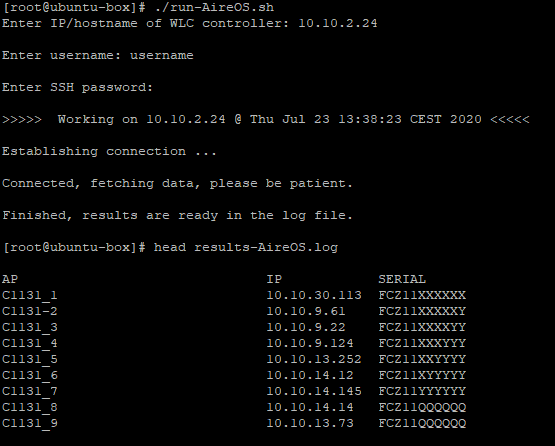Tested on 3702 AP.
Hold mode button and turn on the power. Release the mode button when the LED lights amber. Connect the console cable from PC to AP and connect to it via Putty or any other client that supports serial connections.
If necessary delete some old files first to free some space:
ap: dir flash:
ap: delete flash:ap3g2-k9w7-mx.153-3.JPJ3a/ap3g2-k9w7-mx.153-3.JPJ3a
ap: you sure you want to delete "flash:ap3g2-k9w7-mx.153-3.JPJ3a/ap3g2-k9w7-mx.153-3.JPJ3a" (y/n)?y
File "flash:ap3g2-k9w7-mx.153-3.JPJ3a/ap3g2-k9w7-mx.153-3.JPJ3a" deleted
ap: delete flash:private-multiple-fs
ap: you sure you want to delete "flash:private-multiple-fs" (y/n)?y
File "flash:private-multiple-fs" deleted
On AP, configure temporary network settings, so you can upload new firmware over network later.
ap: set IP_ADDR 192.168.0.1
ap: set NETMASK 255.255.255.0
ap: set DEFAULT_ROUTER 192.168.0.1
ap: tftp_init
tftp_init success: You can now use tftp file system!
ap: ether_init
Ethernet speed is 1000 Mb - FULL duplex
Set up your TFTP server (usually laptop or a PC) network address to the same subnet as the access point’s in the step above. For this example, set the network card address to:
IP address: 192.168.0.2
Subnet mask: 255.255.255.0
For quick access to network cards settings on Windows, go to start and type ncpa.cpl, press enter.
Connect UTP cable from TFTP server to access point and start your TFTP server with loaded firmware. You can use TFTPD32 on Windows – Download.
Go back to AP console and fetch the firmware from TFTP server:
ap: tar -xtract tftp://192.168.0.2/ap3g2-k9w7-tar.153-3.JPJ3a.tar flash:
extracting info (283 bytes)
ap3g2-k9w7-mx.153-3.JPJ3a/ (directory) 0 (bytes)
extracting ap3g2-k9w7-mx.153-3.JPJ3a/ap3g2-k9w7-mx.153-3.JPJ3a (119277 bytes).........................
ap3g2-k9w7-mx.153-3.JPJ3a/html/ (directory) 0 (bytes)
ap3g2-k9w7-mx.153-3.JPJ3a/html/level/ (directory) 0 (bytes)
ap3g2-k9w7-mx.153-3.JPJ3a/html/level/1/ (directory) 0 (bytes)
extracting ap3g2-k9w7-mx.153-3.JPJ3a/html/level/1/appsui.js (563 bytes)
extracting ap3g2-k9w7-mx.153-3.JPJ3a/html/level/1/back.shtml (512 bytes)
extracting ap3g2-k9w7-mx.153-3.JPJ3a/html/level/1/cookies.js (5032 bytes).
extracting ap3g2-k9w7-mx.153-3.JPJ3a/html/level/1/forms.js (20442 bytes)....
extracting ap3g2-k9w7-mx.153-3.JPJ3a/html/level/1/sitewide.js (17250 bytes)...
Wait a few minutes for the process to finish and set AP to boot from new firmware:
ap: set BOOT flash:/ap3g2-k9w7-mx.153-3.JPJ3a/ap3g2-k9w7-mx.153-3.JPJ3a
ap: boot
NOTE: This is not the only way to do it. Here is another way without going into recovery – rommon mode.


